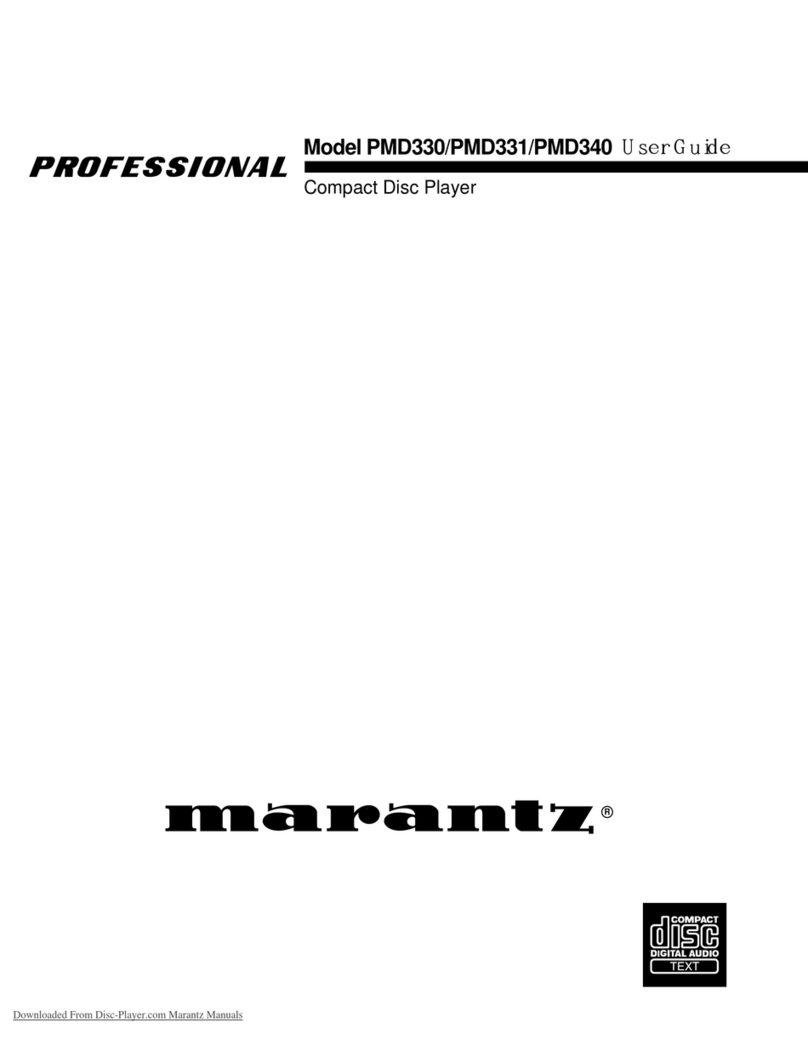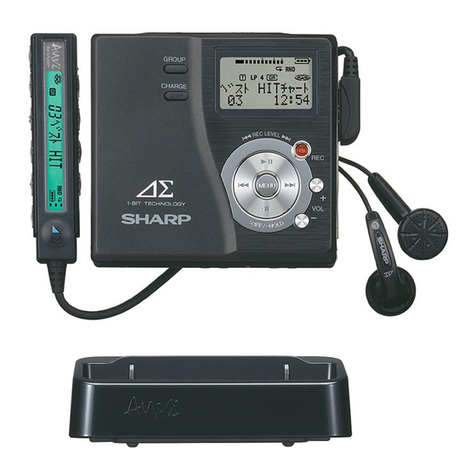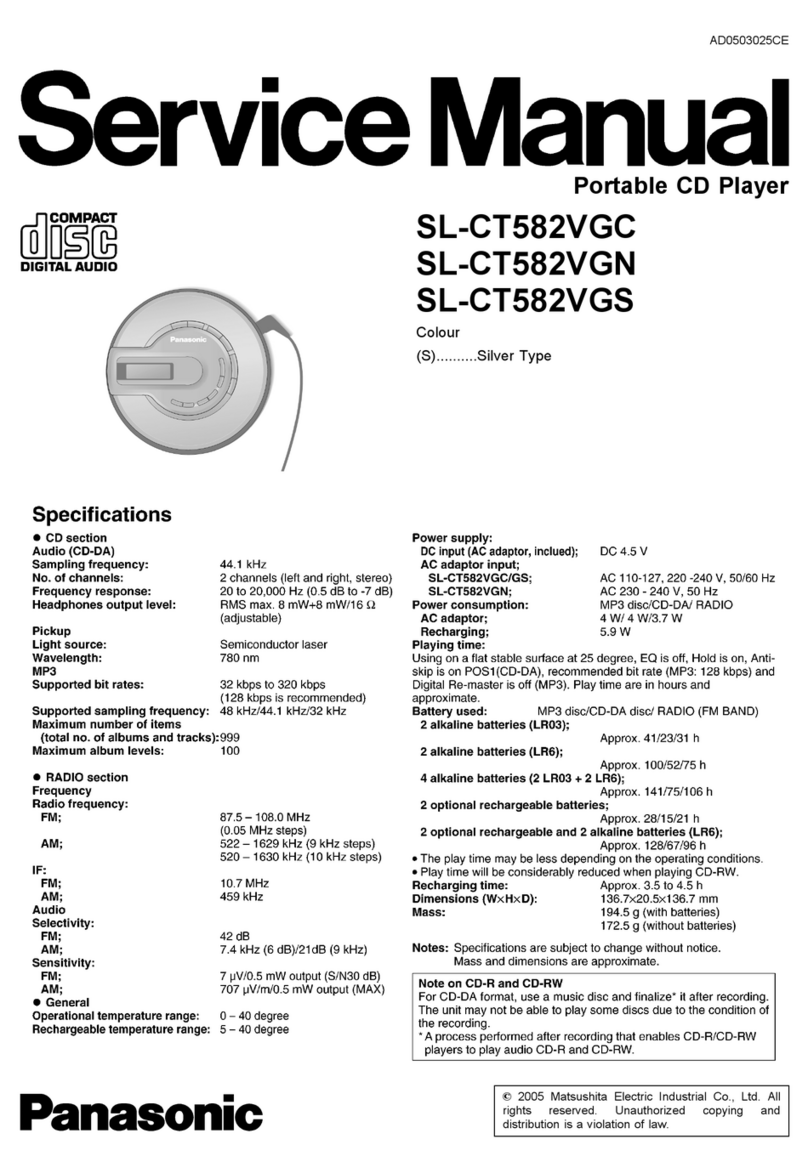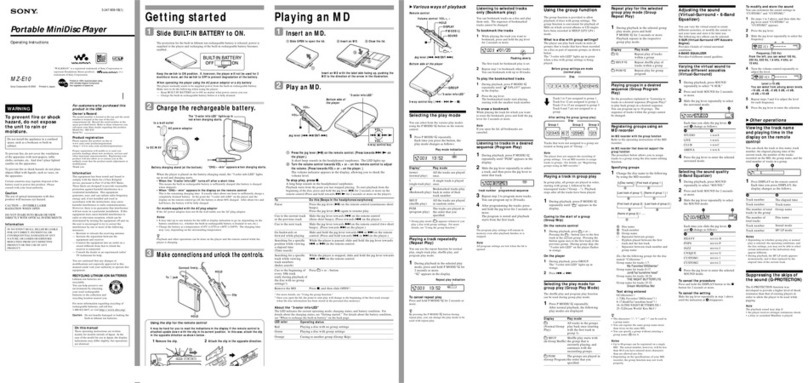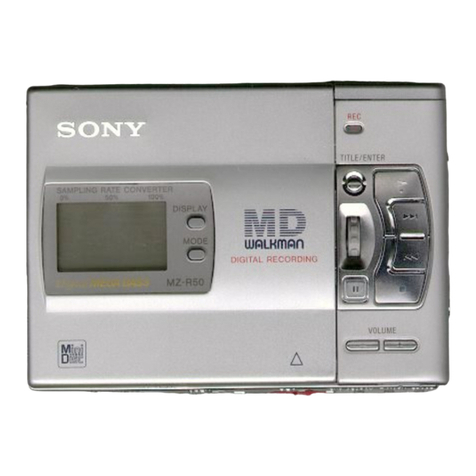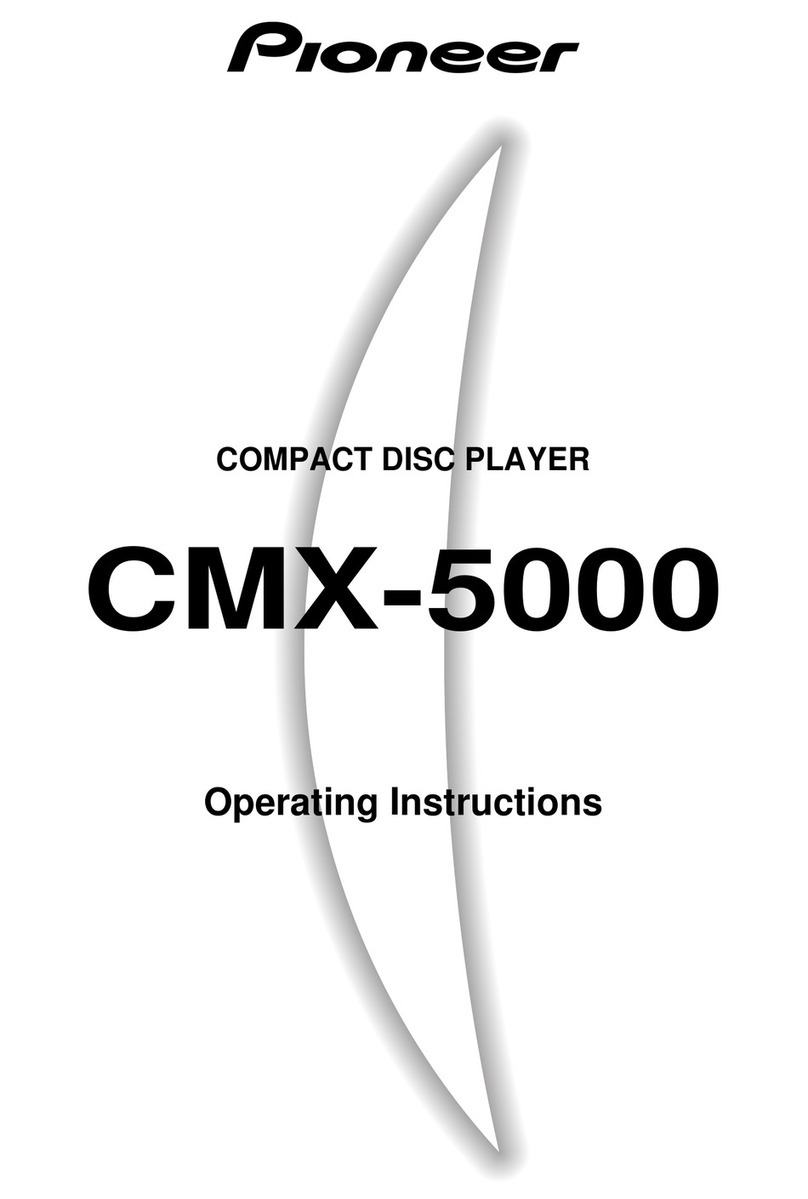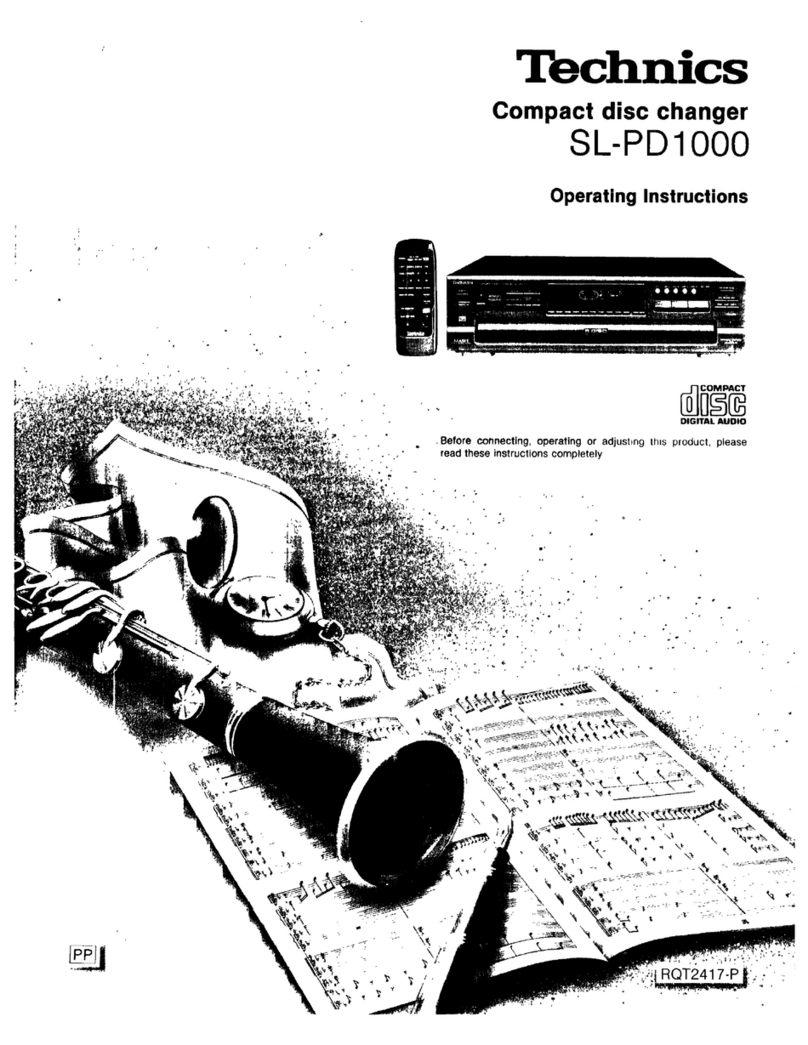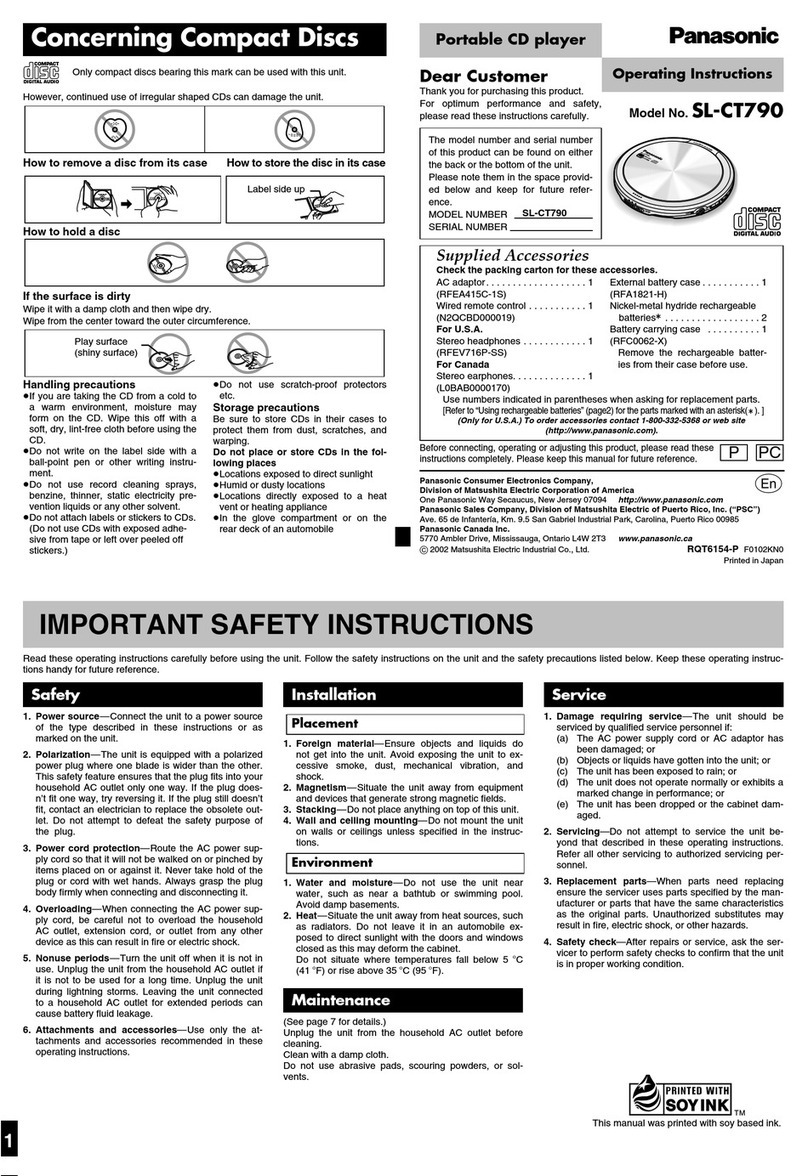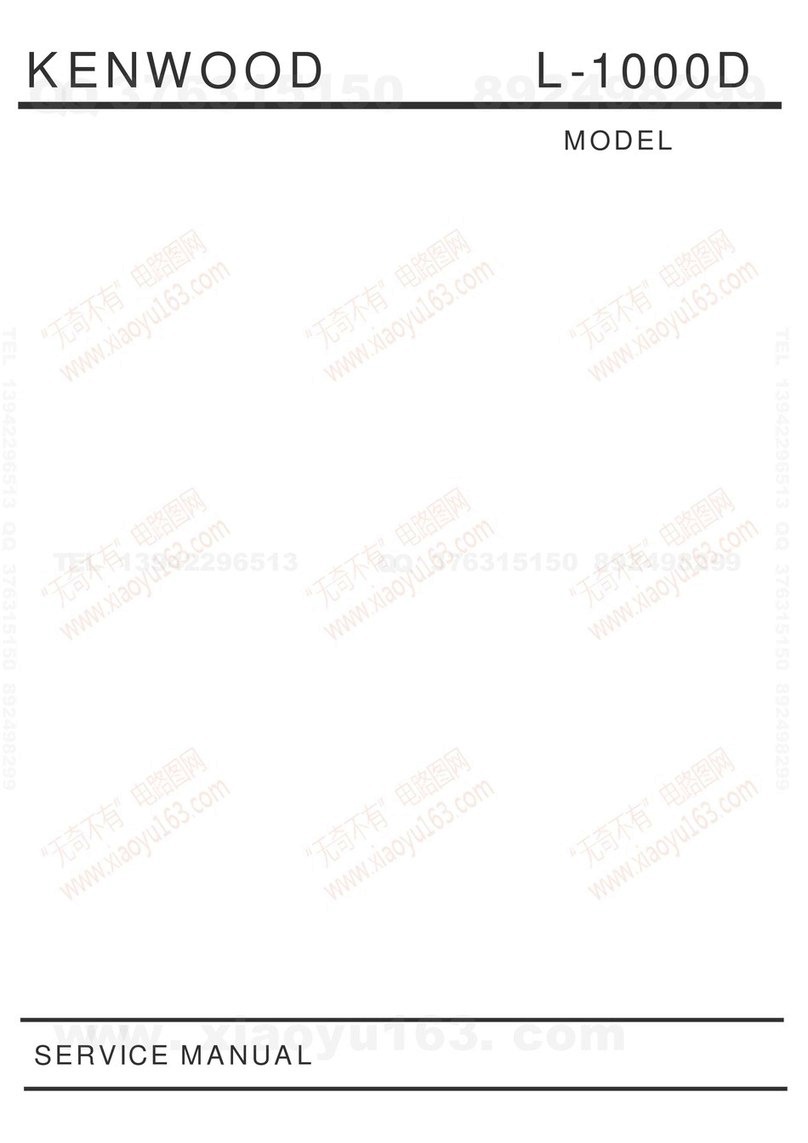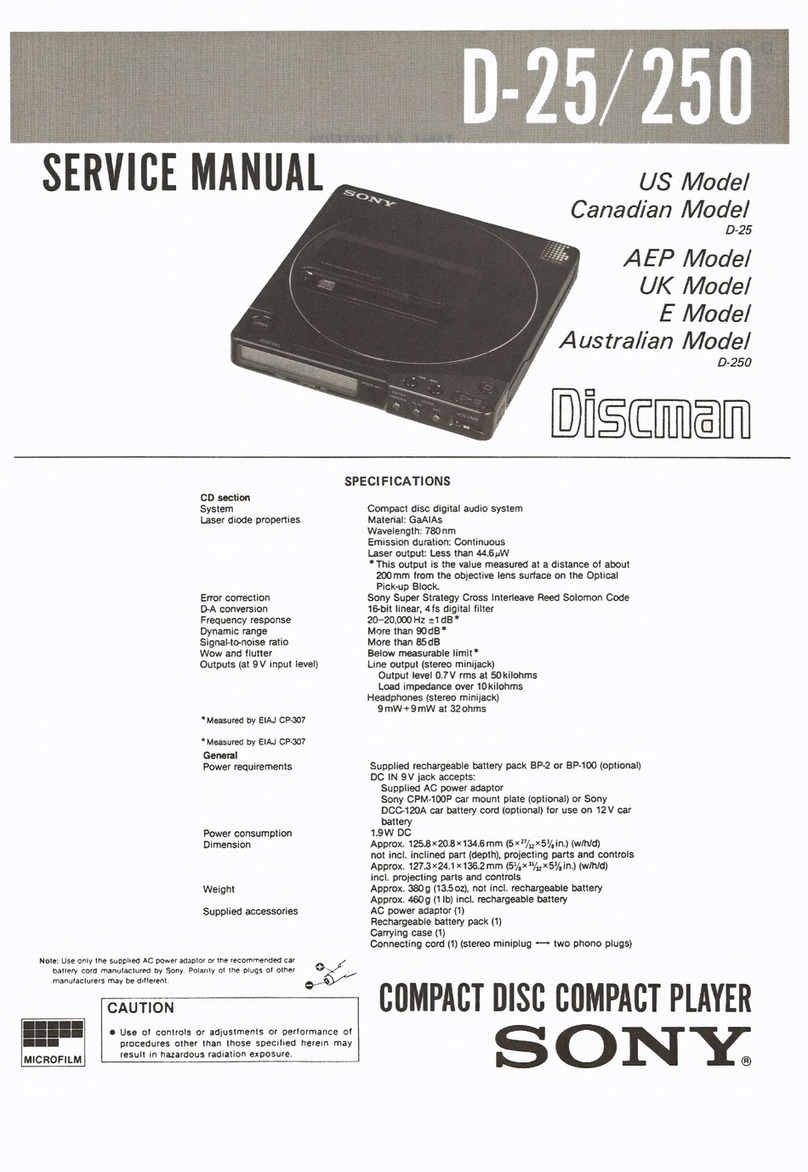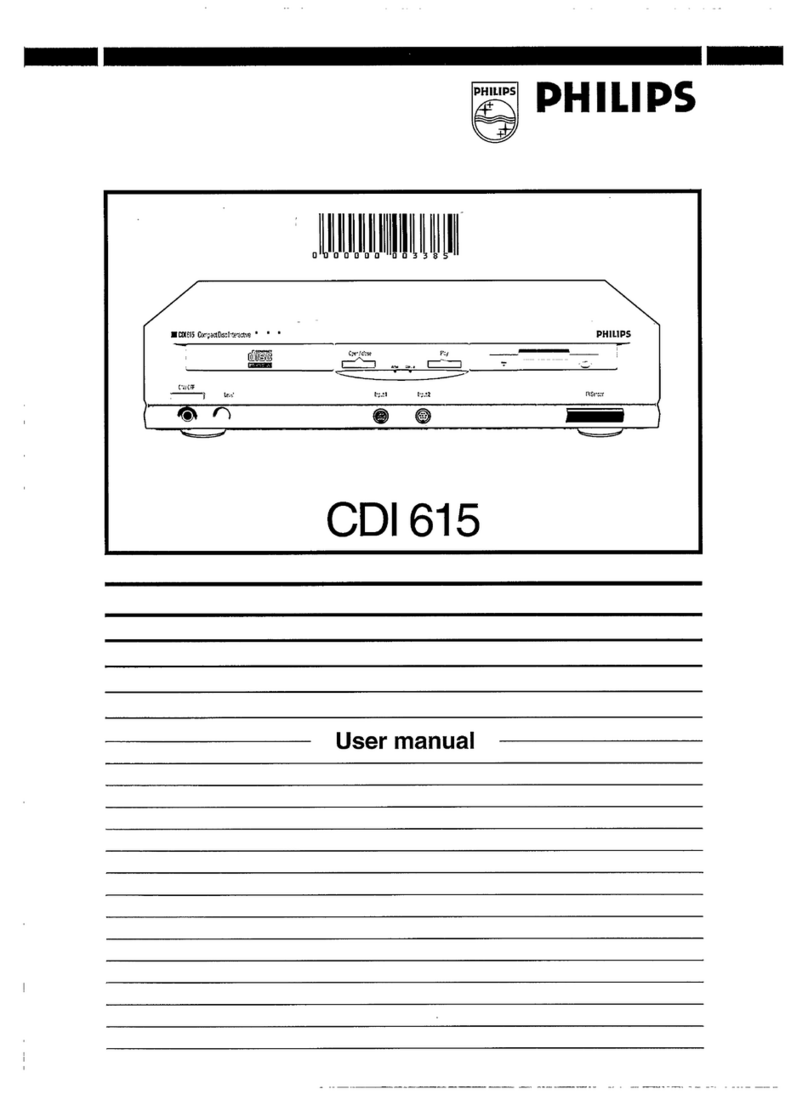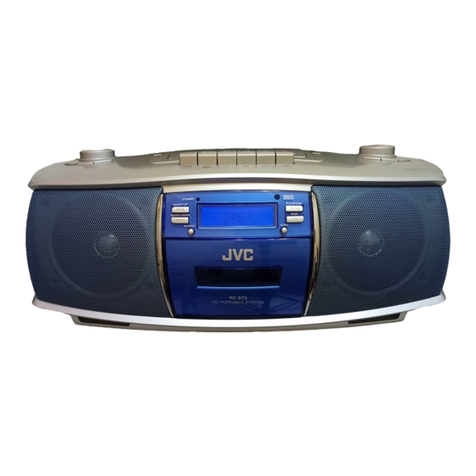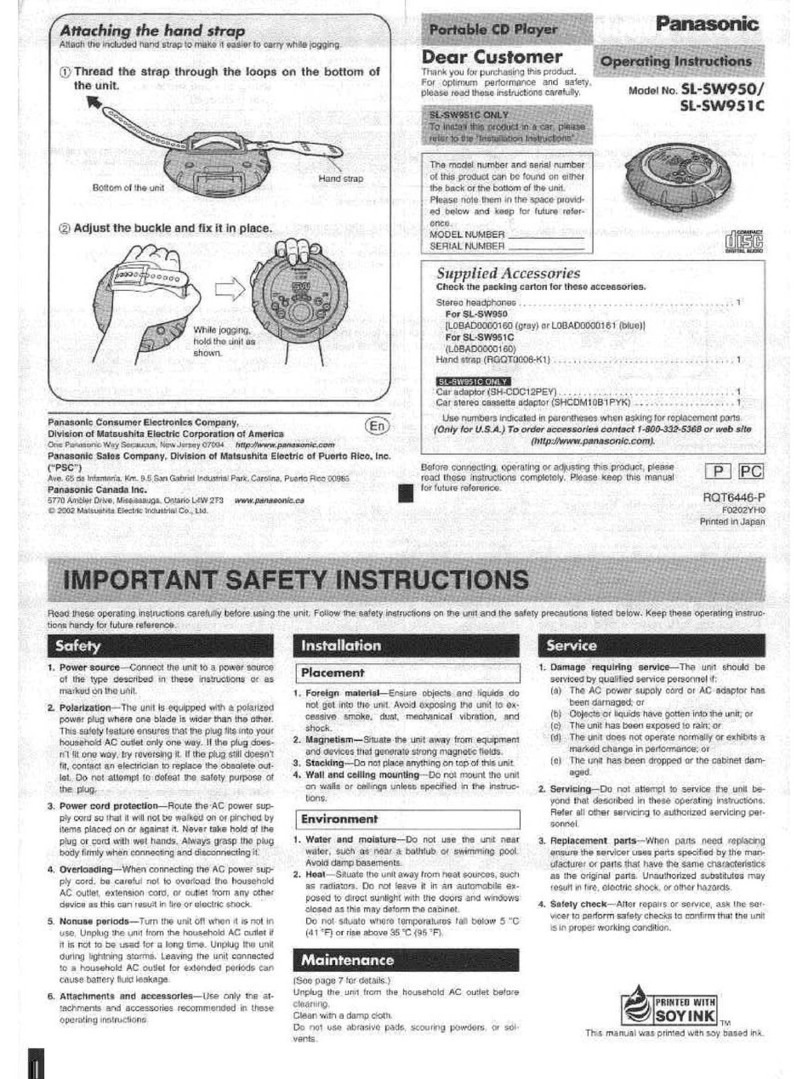Blackmagicdesign HyperDeck Studio User manual

Installation and Operation Manual
HyperDeck
Disk Recorders
February 2017

Welcome
We hope you share our dream for the television industry to become a truly creative
industry by allowing anyone to have access to the highest quality video.
Our range of HyperDeck disk recorders have made it easier and more affordable than
ever to record and play back full 10 Bit uncompressed video and now Ultra HD!
HyperDeck records directly to removable 2.5” Solid State Disks (SSDs) and SD cards that
are getting bigger, faster and more affordable every day. It’s incredible that you can now
record and play the most amazing quality video onto something so small thousands of
times without any degradation in quality!
SSDs and SD cards can also be connected to any computer for immediate editing and fast
transfer of your media. With no moving parts, they are unbelievably robust and can handle
harsh conditions that would destroy conventional hard drives and videotapes!
You can bypass unwanted camera compression and record directly from HDMI or SDI
cameras and even connect to any HDMI or SDI monitor for instant playback.
The HyperDeck Studio Mini model is a small and portable, modular Ultra HD disk recorder
that records on tiny SD cards. With HyperDeck Studio Pro, you can connect analog
sources and also record and play back Ultra HD with 6G-SDI. The HyperDeck Studio 12G
model can record even higher frame rates in Ultra HD up to 60 fps!
If you need longer recording times, then HyperDeck also records and plays back Apple
ProRes and Avid DNx files. These 10 Bit quality codecs retain fantastic picture quality and
increase the recording length of your media by more than 5 times!
This instruction manual contains all the information you need to start using your
HyperDeck disk recorder. For uncompressed recording you need to use an SSD that
supports the required data speed and we are continually adding details on our website of
new SSDs that we have tested.
Please check the support page at www.blackmagicdesign.com for the latest version of
this manual and updates to the HyperDeck software. Keeping your software up to date will
always ensure you get all the latest features. When downloading software, please register
with your information so we can keep you updated when new software is released. We are
constantly working on new features and improvements, so we would love to hear from you!
Grant Petty
CEO Blackmagic Design

Contents
HyperDeck Disk Recorders
Contents
Getting Started 4
Recording 6
Playback 9
HyperDeck Status Indicators 11
About SSDs and SD Cards 11
Blackmagic HyperDeck Setup 17
Control Panel Display Menu 20
RS-422 Control 23
Connecting to an ATEM Switcher 28
Understanding Post Production
Workflows 29
Using DaVinci Resolve 30
Introducing DaVinci Resolve 30
Importing your Clips 31
Editing your Clips 31
Trimming Clips 33
Mapping Keyboard Shortcuts 33
Adding Transitions 34
Adding Titles 35
Adding Audio Tracks 36
Color Correcting your Clips 36
Using Scopes 37
Secondary Color Correction 39
Qualifying a Color 39
Adding a Power Window 40
Tracking a Window 41
Using Plugins 42
Mastering your Edit 42
Developer Information 44
Blackmagic HyperDeck
Ethernet Protocol 44
Protocol Commands 44
Protocol Details 45
Help 54
Regulatory Notices and Safety
Information 55
Warranty 56

Getting Started
Getting Started with Blackmagic HyperDeck
Getting started with your HyperDeck disk recorder is as easy as connecting power, plugging in
your video sources and destination equipment to your HyperDeck’s inputs and outputs and
inserting your SSDs or SD cards.
Plugging in Power
Simply plug a standard IEC cable to your HyperDeck’s power input on the rear panel.
Connect power to your HyperDeck Studio using a standard IEC power cable
Plugging in Video and Audio
Plug your source video to the SDI or HDMI inputs, and your destination equipment to the SDI or
HDMI outputs.
HyperDeck Studio 12G has 12G-SDI connectors so you can input or output Ultra HD up to
2160p60 using a single BNC cable.
HyperDeck Studio Pro provides additional inputs and outputs for connecting video equipment
that supports single link, dual link or quad link Ultra HD.
Plugging in Analog Audio and Timecode on HyperDeck Studio Pro
If you want to connect analog audio sources to HyperDeck Studio Pro, plug into the XLR or RCA
connectors. To select your desired audio input, simply press the ‘input’ button on the front
control panel to cycle through combinations of video and audio inputs. For example, SDI + XLR,
SDI + RCA, and more. External timecode can also be connected to and from your HyperDeck
Studio Pro via the timecode XLR input and output connectors.
HyperDeck Studio Pro lets you plug in external analog audio and timecode
via the rear panel XLR connectors. You can even plug in analog audio from
audio equipment such as iPods and HiFi systems via the RCA inputs.
REF OUT
REF INETHERNET PoE+
SDI OUT
SDI IN
HDMI OUT
REMOTE IN
BA
USB-C
POWER REMOTE
IN
SD/HD/3G/6G-SDI IN
TIMECODE
IN OUT CH 1 CH 2 CH 1 CH 2
ANALOG AUDIO IN ANALOG AUDIO OUT
OUT
IN A
Y IN B-Y IN R-Y IN R-Y OUT REF IN
L
R
STEREO IN
B-Y OUTY OUT
IN B IN C IN D OUT A OUT B OUT C OUT D MON OUT
ETHERNET
PUSH PUSH
HDMI
PUSH
SD/HD/3G/6G-SDI OUT
44Getting Started

Plugging in SSDs and SD Cards
All HyperDeck models ship ready to record immediately without having to configure any
settings. All you need is a formatted SSD or SD card.
You can easily format media via the front LCD based menu settings. You can also format using
a computer.
Refer to the ‘About SSDs and SD Cards’ section in this manual for more information on how to
format, the types of media that are best for recording video and a list of recommended drives
and cards.
To plug in an SSD:
1 Hold a 9.5mm SSD with the connection pins facing the bottom and aligned with your
HyperDeck’s drive bay. Gently push the SSD into the drive bay until you feel it slot
into place.
2 Your HyperDeck will verify the SSD. This is shown by an illuminated green light
surrounding the drive bay. When the light or indicator turns off and the ‘stop’ button on
the control panel is illuminated, your HyperDeck is ready to record.
Hold your SSD with the connection pins facing the bottom, aligned with your HyperDeck’s
drive bay and gently push the SSD into the drive bay until you feel it slot into place
To plug in an SD card:
1 Hold the SD card with the gold connectors facing your HyperDeck’s LCD and align it
with the media slot. Now gently push the card into the slot until you feel it lock firmly
into place.
2 Your HyperDeck will verify the SD card. This is shown by an illuminated green indicator
above the SD card slot. When the indicator turns off and the stop button on the control
panel is illuminated, your HyperDeck is ready to record.
To remove the card, gently push until you feel it click, then release. The card will eject a short
distance, allowing you to hold the edge of the card and remove it from the slot.
Gently push the SD card into the slot until you feel it click into place
Card 1
55Getting Started

Recording
Recording Ultra HD and HD video with HyperDeck
HyperDeck models that support Ultra HD video record compressed Ultra HD using Apple
ProRes, plus Avid DNxHR on HyperDeck Studio 12G and HyperDeck Studio Mini. All HyperDeck
models can record HD video using ProRes and DNxHD codecs. HyperDeck Studio models that
record on SSDs can also record uncompressed HD.
Recording Video with HyperDeck Studio Mini
HyperDeck Studio Mini can record compressed HD and Ultra HD video up to 2160p30
via 6G-SDI.
To record video:
1 Insert your formatted SD card into either of the SD card slots. The indicator above the
slot will illuminate green as your HyperDeck reads the card. When the indicator turns
off, HyperDeck Studio Mini is ready to record.
2 HyperDeck Studio Mini automatically detects when SDI video is connected and
displays the image on the control panel LCD.
If you want to change the codec, you can choose from a variety of codecs using the
control panel LCD menu or the Blackmagic HyperDeck Setup utility software. For more
information, refer to the ‘control panel display menu’ section, or ‘Blackmagic HyperDeck
Setup/selecting your video format’.
3 Press the ‘record’ button and the indicator above the slot will illuminate red.
As your HyperDeck is recording, the slot indicator on the control panel LCD will
alternate between displaying the active slot, and record time remaining on the card.
4 Press the ‘stop’ button to finish recording.
The indicator above the SD card slot illuminates red when recording video
Recording Video with HyperDeck Studio SSD Models
1 Insert your formatted SSD into either SSD slot. The LED strip surrounding the drive
will illuminate green as HyperDeck reads the disk. When the slot light turns off, your
HyperDeck is ready to record.
2 Press the input button on the control panel to cycle through your HyperDeck’s inputs.
When your connected source is selected, it will appear on the control panel LCD.
For HyperDeck Studio Pro, pressing the input button will also cycle through
combinations of video and audio connections, for example SDI + SDI, SDI + XLR, and
SDI + RCA. This lets you record SDI or HDMI video with external audio.
01:23:47:08
2160p30 Card 2
01:23:47:08
1080p59.94 SD 2
66Recording

If you want to record using a different codec, you can choose from a variety of codecs using the
control panel LCD menu or the HyperDeck Setup utility software. See the ‘control panel display
menu’ section, or ‘Blackmagic HyperDeck Setup/selecting your video format’ section for more
information.
3 Press the ‘record’ button to start recording instantly. A looping red light on the SSD slot
indicates the SSD is recording.
4 Press the ‘stop’ button to finish your recording.
On HyperDecks with SSD slots, the slot indicator will illuminate red to show the unit is recording
Recording using Dual Media Slots
When there is less than 3 minutes of record time remaining on your SD card or SSD, the
timecode counter on your HyperDeck’s LCD will turn red and the ‘stop’ button will flash slowly.
This also means there is no second disk with space that recording can continue onto. In this
case, you simply need to insert a disk with space so recording can continue. Once you insert a
blank disk into the slot that’s not being used for recording, the slow flashing will stop and this
means HyperDeck can continue to record, because this second disk has been checked ok and
there is space to keep recording.
INPUT
DISP
SET
REM
JOG
01:42:56:12
SSD 2
INPUT
DISP
SET
REM
JOG
01:42:56:12
SSD 2
TIP If HyperDeck records from a video source that contains closed caption data, the
QuickTime or MXF movie will be recorded as well as a separate .MCC file containing
the closed caption data.
01:42:56:12
SSD 2
01:42:56:12
21
If you have less than three minutes
of recording time left on your current
disk and no formatted media in your
HyperDeck’s second slot, the timecode
indicator will turn red indicating your
recording is about to stop.
If there is space on a formatted
disk in the second slot, HyperDeck
will display an icon in the top right
corner to indicate that recording will
automatically switch over
once the current disk is full.
77Recording

If you want to change the disk you are recording to at any time, and you have a second disk that
has free space, then simply hold down the record button and the recording will move from the
current disk to the second disk. This is very useful when you want to get that disk out of the
HyperDeck without pausing recording. This can happen during live events when you need to
get an important recording out to another location, but you don’t want to miss anything and you
don’t want to stop recording.
If the ‘record’ button flashes quickly, this means the disk is not fast enough for sustained
recording. In this case, if you are recording uncompressed HD, we recommend changing to a
compressed recording format such as ProRes or DNxHD, or if you are recording compressed
video and the record button flashes quickly, try using faster recommended media.
Ref Input
If your HyperDeck has a reference input, it can accept black burst and tri-level sync signals from
a sync generator. Connect a reference source to this input if you want to synchronize
HyperDeck with other video equipment, such as a production switcher.
If your HyperDeck has a reference input, you can sync your HyperDeck with other
video equipment
Ref Output
The reference output on HyperDeck Studio Mini lets you connect an internally generated black
burst or tri-level sync signal to other video equipment if you want to synchronize other
equipment with your HyperDeck.
On HyperDeck Studio Mini you can sync other video equipment with your HyperDeck
using the reference output
REMOTE
ETHERNET SD/HD/3GHD-SDI HDMI
IN OUT
REF INMON OUTOUT 2OUT 1LOOP OUTIN
INPUT
DISP
SET
REM
JOG
REMOTE ETHERNET SD/HD/3GHD-SDI HDMI
IN OUT
REF INMON OUTOUT 2OUT 1LOOP OUTIN
INPUT
DISP
SET
REM
JOG
REF OUT
REF INETHERNET PoE+
SDI OUT
SDI IN
HDMI OUT
REMOTE IN
BA
USB-C
REF OUT
REF INETHERNET PoE+
SDI OUT
SDI IN
HDMI OUT
REMOTE IN
BA
USB-C
88Recording

Playback
Playing Video with HyperDeck
1 Press the ‘play’ button once for instant playback and you’ll see your video on the LCD,
and any displays connected to your HyperDeck’s video outputs. When a clip is playing,
pressing ‘play’ again will loop it continuously. On HyperDeck Studio Mini, pressing play
a third time will let you loop all recorded clips.
2 To skip to the next clip, press the ‘next clip’ button on the control panel.
3 Press ‘previous clip’ once to go to the start of the current clip or press twice to skip
back to the start of the previous clip.
Press the play button on your HyperDeck’s control panel to play back a clip, and press
the forward or reverse skip buttons to restart the current clip or skip to a different one
If the play button flashes on HyperDecks that record on SSDs, this means the disk is not fast
enough and playback cannot keep up. We recommend you change to a compressed recording
format such as ProRes or DNxHD, or use a faster recommended SSD for uncompressed or Ultra
HD recording.
SSD slots have rotating LEDs to show the unit is in playback mode
NOTE With HyperDeck Studio Pro, you can choose to play back Ultra HD
using single link, dual link or quad link outputs. Refer to the ‘Ultra HD Playback
on HyperDeck Studio Pro’ section for more information.
01:23:47:08
1080p59.94 Card 2
01:23:47:08
1080p59.94 SD 2
01:23:47:08
1080p59.94 SD 2
01:42:56:12
SSD 2
INPUT
DISP
SET
REM
JOG
01:42:56:12
SSD 2
INPUT
DISP
SET
REM
JOG
99Playback

Ultra HD Playback on HyperDeck Studio Pro
HyperDeck Studio Pro can play back Ultra HD video via single link 6G-SDI, dual link 3G-SDI,
and quad link HD-SDI.
To select your desired Ultra HD playback output:
1 Press the ‘disp’ button to open the control panel LCD menu.
2 Using the jog/shuttle wheel and ‘set’ button, select ‘video’, then ‘2160p SDI out’.
3 Select your desired output type and press ‘set’ to confirm. Press the ‘disp’ button to
close the menu.
For HyperDeck Studio Pro, you can choose between single link 6G-SDI,
dual link 3G-SDI or quad link HD-SDI for Ultra HD playback
Jog or Shuttle
You can use the jog or shuttle wheel to shuttle to a particular section at variable speeds. The
more you turn it forwards or backwards, the faster your HyperDeck Studio will play through your
video. Once you’ve found the section you want to review, press ‘play’ to resume
normal playback.
If you want to slowly jog through your video frame by frame, press the ‘jog’ button once to
enable jog operation. Turning the jog or shuttle wheel in the desired direction will then jog
through your video. Pressing the ‘jog’ button again will return the wheel to shuttle operation.
If your HyperDeck has ‘reverse’ or ‘fast forward’ buttons, you can press these buttons to play
through the clip at 2x speed. Press the ‘reverse’ or ‘fast forward’ buttons again and the speed
will increase to 4x and then 8x. Once you’ve found the section you want to review, press ‘play’
to resume normal playback.
On HyperDecks with fast forward and reverse buttons, press the buttons repeatedly
to gradually shuttle playback forwards and backwards at faster speeds
TIP If you play back a video clip that has an associated .MCC file, the closed caption
data will be played out with the video via the SDI output of your HyperDeck.
INPUT
DISP
SET
REM
JOG
2160p SDI Out
Dual 3G-SDI
Quad HD-SDI
Video In
4K SDI Out
Single 6G-SDI
INPUT
DISP
SET
REM
JOG
01:42:56:12
SSD 2
INPUT
DISP
SET
REM
JOG
01:42:56:12
SSD 2
1010Playback

HyperDeck Status Indicators
Status Indicators
When recording or playing video with HyperDeck, any information you need to know is
displayed on the unit itself via LED indicators for each media slot and the built in LCD.
Media Slot Indicators
When you first power on HyperDeck, or any time you insert an SSD or SD card, the slot
indicator will illuminate green while checking the media and then switch off. If the disk has not
been formatted correctly, or fails to work, the slot will illuminate solid red until the disk is
removed. In this case, check if the disk is formatted correctly and also check that it works with
a computer.
HyperDeck’s media slot indicators illuminate to let you know the status of
the disk, for example red when recording, and green during playback
Control Panel LCD
HyperDeck Disk Recorders feature an LCD that not only shows your video but also displays
status information such as video format and frame rate, record, playback and jog modes, the
active media slot as well as timecode and audio levels.
HyperDecks have a built in LCD that shows your video as well as status information
About SSDs and SD Cards
Choosing a Fast SSD
When working with high data rate video it’s important to carefully check the SSD you would like
to use. This is because some SSDs can have up to 50% lower write speed than the
manufacturer’s claimed speed, so even though the disk specifications claim an SSD is fast
enough to handle video, in reality the disk is not fast enough for real time video recording.
Hidden data compression mostly affects recording and often these disks can still be used for
real time playback.
01:23:47:08
2160p30 Card 2
01:23:47:08
1080p59.94 SD 2
01:42:56:12
SSD 1
INPUT
DISP
SET
REM
JOG
1111HyperDeck Status Indicators

In our testing, we have found larger newer models of SSD and larger capacity SSDs are
generally faster. SSDs recommended for use with HyperDeck for uncompressed 10 Bit HD and
ProRes or DNxHR Ultra HD video recording include:
Brand SSD Name/Model Number Storage Supported Formats
10-bit
uncompressed
HD and UltraHD
ProRes or DNxHR
HDProRes
and
DNxHD
ADATA XPG SX900. ASX900S3-256GM-C. 256GB Yes Yes
Angelbird AV Pro. 480GB Yes Yes
AV Pro. 240GB Yes Yes
Crucial M4 (firmware 009 only). CT512M4SSD2. 512GB Yes Yes
M4 (firmware 000F only). CT256M4SSD2. 256GB No Yes
Digistor 4K Professional Video Series.
DIG-PVD1000, pre-formatted exFat. 1TB
Yes
Except HyperDeck
Shuttle
Yes
Except HyperDeck
Shuttlew
Professional Video Series.
DIG-PVD480S, pre-formatted exFat. 480GB Yes Yes
Professional Video Series.
DIG-PVD240S, pre-formatted exFat 240GB Yes Yes
Intel 520 series. SSDSC2CW480A310. 480GB Yes Yes
520 series. SSDSC2CW240A310. 240GB Yes Yes
530 series. SSDSC2BW240A401. 240GB Yes Yes
530 series. SSDSC2BW180A401. 180GB Yes Yes
335 series. SSDSC2CT240A4K5. 240GB Yes Yes
Kingston HyperX 3K. SH103S3/480G. 480GB Yes Yes
HyperX 3K. SH103S3/240G. 240GB Yes Yes
SSDNow KC300. SKC300S37A/480G. 480GB Yes Yes
SSDNow KC300.SKC300S37A/240G. 240GB Yes Yes
OCZ Agility 3. AGT3-25SAT3-240G. 240GB No Yes
OWC Mercury Extreme Pro 6G.
OWCSSD7P6G480. 480GB Yes Yes
Mercury Extreme Pro 6G.
OWCSSD7P6G240. 240GB Yes Yes
Mercury Extreme Pro 6G.
OWCSSD7P6G120. 120GB Yes Yes
Samsung 850 Pro. MZ-1T0BW, spacer required. 1TB
Yes
Except HyperDeck
Shuttle
Yes
Except HyperDeck
Shuttle
850 Pro. MZ-7KE512BW, spacer required. 512GB Yes Yes
850 Pro. MZ-7KE256BW, spacer required. 256GB Yes Yes
SanDisk Extreme Pro. SDSSDXPS-240G-G25. 240GB Yes Yes
Extreme Pro. SDSSDXPS-480G-G25. 480GB Yes Yes
Extreme Pro. SDSSDXPS-960G-G25. 960GB Yes Yes
Extreme. SDSSDX-480G-G25. 480GB Yes Yes
1212About SSDs and SD Cards

Brand SSD Name/Model Number Storage Supported Formats
10-bit
uncompressed
HD and UltraHD
ProRes or DNxHR
HDProRes
and
DNxHD
Extreme. SDSSDX-240G-G25. 240GB Yes Yes
Extreme. SDSSDX-120G-G25. 120GB No Yes
PNY Prevail. SSD9SC480GCDA-PB. 480GB Yes Yes
Prevail. SSD9SC240GCDA-PB. 240GB Yes Yes
XLR8. SSD9SC480GMDA-RB. 480GB Yes Yes
Transcend SSD370. TS1TSSD370. 1TB Yes Yes
SSD370. TS512GSSD370. 512GB Yes Yes
SSD370. TS256GSSD370. 256GB Yes Yes
SSD720. TS256GSSD720. 256GB Yes Yes
Please visit the Blackmagic Design support center at www.blackmagicdesign.com for the latest
support notes and information. If you find an SSD that isn’t fast enough for uncompressed HD
video or Ultra HD, try a faster SSD or switch to a compressed recording format such as ProRes
or DNxHD. These recording formats have a much lower data rate and are easier for the SSD
to handle.
Choosing a fast SD Card
For high quality HD recording on HyperDeck Studio Mini, we recommend high speed UHS-II SD
cards. These cards need to be capable of write speeds above 110MB/s for recording up to Ultra
HD 2160p30. However, if you are recording standard definition or lower bit rate, lower quality
compression you might be able to use slower cards. Generally the faster the cards, the better.
It’s worth regularly checking the latest version of this manual for more up to date information
and can always be downloaded from the Blackmagic Design website at
www.blackmagicdesign.com/support
Brand Card Name Storage Max Read/Write
Speed Supported Formats
Ultra HD ProRes
or DNxHR
HD ProRes or
DNxHD
Lexar Professional
2000x 64 GB 300 MB/s Yes Yes
Sandisk Extreme Pro 128 GB 300 MB/s Yes Yes
64 GB 300 MB/s Yes Yes
32 GB 300 MB/s Yes Yes
Sandisk Extreme Pro 64 GB 95 MB/s No Yes
32 GB 95 MB/s No Yes
Sandisk Extreme 64 GB 90 MB/s No Yes
Sandisk Extreme Plus 64 GB 90 MB/s No Yes
1313About SSDs and SD Cards

Formatting SSDs and SD Cards
Media used by HyperDeck must be formatted as either HFS+ or exFAT. These disk formats
allow long clips to be recorded as single files. You can easily format a card or SSD via the
format feature in HyperDeck’s LCD menu, or via a Windows or macOS computer.
HFS+ is also known as Mac OS Extended and is the recommended format for HyperDeck as it
supports journaling. Data on a journaled disk is more quickly recovered in the rare event it
becomes corrupted, and less likely to be corrupted in the first place. HFS+ is natively supported
by macOS.
ExFAT is supported natively by macOS and Windows without needing to purchase any
additional software. However, exFAT does not support journaling.
While navigating through the format feature on the LCD menu, you’ll have plenty of
opportunities to cancel the format and return to the previous menu by selecting the return
arrow on the bottom right of the LCD and pressing the ‘set’ button on the control panel, or by
pressing the menu button on HyperDeck Studio Mini. Always press the ‘set’ button to confirm
settings and enter setting menus.
To format using your HyperDeck:
1 Insert the media you want to format into either of the SD card or SSD slots.
2 Press the ‘disp’ or ‘menu’ button on your HyperDeck’s control panel.
3 On HyperDecks that record on SSDs, turn the jog/shuttle wheel and press the set
button to select ‘format SSD’ on the LCD menu.
On HyperDeck Studio Mini, turn the jog/shuttle wheel and use the set button to enter
the ‘record’ menu on the LCD and select ‘format card’.
Turn the jog/shuttle wheel clockwise to select ‘format SSD’ on the LCD menu. On
HyperDeck Studio Mini, the ‘format card’ setting is in the ‘record’ menu.
4 Select the SD card or SSD you want to format on the LCD using the jog/shuttle wheel.
Remember to press the ‘set’ button to confirm your selection.
5 Now set your desired format from the ‘HFS+’ or ‘exFAT’ options.
6 A warning message will appear on the LCD asking you to confirm the format. Make sure
you have backed up any important data before you confirm as this action cannot be
undone. Confirm the format by selecting ‘format’ for SD cards, or ‘format SSD’ using the
jog/shuttle wheel and pressing the ‘set’ button.
Main MenuVideo
Timecode
Setup
Format
SSD
Record
Select
Open
SET
Audio Channels
Format Card
Record Trigger
Codec
4 Channels
None
ProRes HQ
Record
1414About SSDs and SD Cards

Set your desired format from the HFS+ or exFAT options.
On HyperDeck Studio Mini, HFS+ is labeled ‘OS X Extended’
Confirm the format by using the jog/shuttle wheel and pressing the set button
A progress bar will show you the formatting progress. When your HyperDeck has finished
formatting, ‘formatting complete’ will display on the LCD. Press the ‘set’ button again to return
to the menu.
Formatting Media on a macOS Computer
The Disk Utility application included with macOS can format a drive in the HFS+ or exFAT
formats. Make sure you back up anything important from your disk as you will lose everything
on it when it is formatted.
To format on a macOS computer:
1 Connect an SSD to your computer with an external dock or cable adapter and dismiss
any message offering to use your SSD for Time Machine backups.
For SD cards, insert the card into your computer’s SD card slot, or connect it to your
computer via an external card reader.
2 Go to applications/utilities and launch Disk Utility.
3 Click on the disk icon of your SSD or SD card and then click the erase tab.
4 Set the format to Mac OS Extended (Journaled) or exFAT.
5 Type a name for the new volume and then click erase. Your media will quickly be
formatted and made ready for use with HyperDeck.
Select Format
exFat
OS X Extended
Format SSD 1
exFAT
Format
SSD 1
Format
SSD 2
HFS+
Cancel
This will erase all data from your card
This action cannot be undone.
Format SD 2 to OS X Extended?
Format
!
Format SSD 1 as HFS+?
CancelFormat SSD
This action cannotbeundone.
Yourdisk’s contents will be erased.
1515About SSDs and SD Cards

Use Disk Utility on macOS to erase your SSD or SD card in the
Mac OS Extended (Journaled) or exFAT format
Formatting Media on a Windows computer
The format dialog box can format a drive in the exFAT format on a Windows PC. Make sure you
back up anything important from your SSD or SD card as you will lose everything on it when it is
formatted.
To format on a Windows computer:
1 Connect an SSD to your computer with an external dock or cable adapter.
For SD cards, insert the card into your computer’s SD card slot, or connect it to your
computer via an external card reader.
2 Open the start menu or start screen and choose computer. Right-click on your
SSD or SD card.
3 From the contextual menu, choose format.
4 Set the file system to exFAT and the allocation unit size to 128 kilobytes.
5 Type a volume label, select quick format and click Start.
6 Your media will quickly be formatted and made ready for use with HyperDeck.
1616About SSDs and SD Cards

Use the Format dialog box feature in Windows to format
your SSD or SD card in the exFAT format
Blackmagic HyperDeck Setup
Using HyperDeck Setup
Blackmagic HyperDeck Setup is used to change settings and update the internal software in
your HyperDeck. In addition to installing HyperDeck Setup, uncompressed 10 bit codecs are
installed for Mac and Windows.
The home page of HyperDeck Setup. If you have multiple HyperDecks
connected to your computer, you can choose between them by
clicking on the arrows at the sides of the home page
1717Blackmagic HyperDeck Setup

How to Update Your HyperDeck Software on macOS
1 Download and unzip the HyperDeck Setup software.
2 Open the resulting disk image and launch the HyperDeck Installer.
Follow the onscreen instructions.
3 After installing, connect a USB cable from HyperDeck to your computer.
4 Launch Blackmagic HyperDeck Setup and follow any onscreen prompt to update the
internal software in your HyperDeck. If no prompt appears, the internal software is up
to date and there is nothing further you need to do.
How to Update Your HyperDeck Software on Windows
1 Download and unzip the HyperDeck Setup software.
2 You should see a HyperDeck Setup folder containing this manual and the HyperDeck
Setup utility installer. Double-click the installer and follow the onscreen prompts to
complete the installation.
3 After installing, connect a USB cable from HyperDeck to your computer.
4 Launch Blackmagic HyperDeck Setup and follow any onscreen prompt to update the
internal software in your HyperDeck. If no prompt appears, the internal software is up
to date and there is nothing further you need to do.
Selecting Your Video Format
All HyperDecks record compressed HD video using Apple ProRes and Avid DNxHD codecs.
HyperDeck models that record on SSDs can also record uncompressed HD video.
HyperDeck Studio Pro records Ultra HD using ProRes codecs. HyperDeck Studio Mini and
HyperDeck Studio 12G support ProRes and DNxHR for Ultra HD recording.
You can change the codec you want from the front panel LCD menu, or you can use the
HyperDeck Setup software utility depending on what you prefer. For more information on how
to change your codec using the front panel, refer to the ‘control panel display menu’ section.
HyperDecks that record on SSDs can record 10-bit uncompressed QuickTime files on a fast
SSD, or to a compressed format if you have a slower SSD or want to fit longer high definition
recordings on a single SSD. This means if you have changed the format between recording
clips, it is possible to have uncompressed QuickTime files as well as compressed files on the
same disk.
Working with uncompressed video is exciting as there is simply no better quality. However, if
compressed video better suits your workflow, or if you need to fit more video on a SSD, you
can choose a high quality professional compressed video format which is also perfect
for editing.
To choose a video format using HyperDeck Setup:
1 Connect HyperDeck to your computer via USB.
2 Launch HyperDeck Setup. Your HyperDeck model will be named in the setup utility
home page.
3 Click on the circular ‘setup’ icon or the image of your HyperDeck to open the
settings page.
4 In the ‘record’ settings, click on the ‘codec’ drop down menu and select your desired
codec. Click ‘save’ to confirm your setting.
1818Blackmagic HyperDeck Setup

REF OUT
REF INETHERNET PoE+
SDI OUT
SDI IN
HDMI OUT
REMOTE IN
BA
USB-C
REF OUT
REF INETHERNET PoE+
SDI OUT
SDI IN
HDMI OUT
REMOTE IN
BA
USB-C
To change settings using HyperDeck Setup, plug HyperDeck
into your computer via the USB port
Use HyperDeck Setup to select your desired recording and playback format
All subsequent clips will be recorded in the chosen format.
Setting the recording format also sets the playback format. For example, if you want to play
back an uncompressed 10-bit QuickTime file, set the recording format to Uncompressed 10-bit
QuickTime. Setting Avid DNxHD as the recording format lets you play DNxHD QuickTime and
MXF clips, and by selecting Apple ProRes you can play clips using any of the ProRes codecs.
ProRes codecs include:
Codecs Bit Depth Description
Apple ProRes
Codecs
ProRes 422 HQ 10-bit For the highest quality HD and Ultra HD compression at the maximum
ProRes data rate.
ProRes 422 10-bit For extremely high quality HD and Ultra HD compression using a low
ProRes data rate.
ProRes 422 LT 10-bit For high quality HD and Ultra HD compression at a lower ProRes
data rate.
ProRes 422 Proxy 10-bit For high quality offline compression of HD and Ultra HD at the lowest
ProRes data rate.
Avid DNxHR and
DNxHD Codecs
DNxHR HQX 10-bit For the highest quality Ultra HD compression at the maximum DNxHR
data rate.
DNxHR SQ 8-bit For extremely high quality Ultra HD compression using a low DNxHR
data rate.
1919Blackmagic HyperDeck Setup

Codecs Bit Depth Description
DNxHR LB 8-bit For high quality compression of Ultra HD using a lower DNxHR
data rate.
DNxHD 220 10-bit For the highest quality HD compression at the maximum DNxHD
data rate.
DNxHD 145 8-bit For extremely high quality HD compression using a low DNxHD
data rate.
DNxHD 45 8-bit For high quality HD compression at a lower DNxHD data rate.
Control Panel Display Menu
Using the Display Menu
Use your HyperDeck’s control panel display menu to change your video and audio inputs and
outputs as well as any settings changes you would make in HyperDeck Setup such as trigger
recording, timecode output and your chosen recording codec.
HyperDeck Studio Mini has a list based menu, and HyperDecks that record on SSDs have a
tile based menu, so the position of some settings in the menu may appear slightly different
To change a setting in the menu:
1 Press the ‘display’ or ‘menu’ button to display the main menu.
2 Use the jog/shuttle wheel on the front of HyperDeck to highlight different options.
3 Press the ‘set’ button to confirm a selection.
4 To return to a previous menu, press the ‘menu’ button on HyperDeck Studio Mini, or
scroll to the ‘return’ arrow and press ‘set.
5 Press the ‘display’ or ‘menu’ button to exit.
CodecCodec
ProRes
ProRes LT
ProRes Proxy
Uncomp 10-bit
Record
Trigger ProRes HQ
Codec
ProRes LT
ProRes Proxy
ProRes
ProRes HQ
2020Control Panel Display Menu
Other manuals for HyperDeck Studio
4
Table of contents
